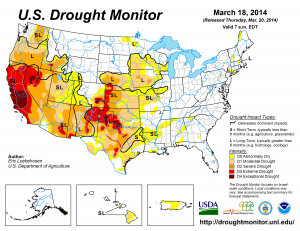World Water Day – Are We Nuts???
Saturday is World Water Day, as declared by the United Nations. As good folks around the world wring their hands over the looming shortage of freshwater for a growing world population, I’d like to take this opportunity to point out the obvious:
If a growing population is creating the problem, then let’s stop growing the population.
 Yet, even the UN’s World Water Day rhetoric tap-dances around the subject (it’s actually the biggest bunch of gobbledygook I’ve seen in a long time). I guess curbing population growth as a response to all the water crisis news and forecasts is just too simple, too obvious, to get our attention. It isn’t considered. If you review the volumes of material on the subject – the news stories, studies, the commentaries and the policy prescriptions, you’ll find it has never occurred to anyone to just stop growing the population (and perhaps, even, to let the population shrink). You have to admit, that would make it a LOT easier to ensure adequate water, food and energy for everyone.
Yet, even the UN’s World Water Day rhetoric tap-dances around the subject (it’s actually the biggest bunch of gobbledygook I’ve seen in a long time). I guess curbing population growth as a response to all the water crisis news and forecasts is just too simple, too obvious, to get our attention. It isn’t considered. If you review the volumes of material on the subject – the news stories, studies, the commentaries and the policy prescriptions, you’ll find it has never occurred to anyone to just stop growing the population (and perhaps, even, to let the population shrink). You have to admit, that would make it a LOT easier to ensure adequate water, food and energy for everyone.
Why is that not on the table? I’ll get to that. But first let me give you a representative sample of the extent of the problem, straight from the news:
California: The state is in a water emergency today. Things have been quite dry. 2013 was the driest year in 119 years. Precipitation since October 1 has averaged less than half of normal across much of the state, and less than 30% of normal in some areas. Governor Jerry Brown declared a statewide drought emergency in January. It’s bad. Worse than anyone has seen. There is good reason to believe this is the general long-term trend, not just a brief dry spell.
 Food growers are being impacted. California supplies nearly half of all U.S. fruits, vegetables and nuts. The State Water Project has announced it will cut off water deliveries for the first time in its 54-year history, and the U.S. government announced farmers should expect no water from the Central Valley Project. The price for water has increased tenfold, from $135 an acre-foot last year to $1,350 an acre-foot in the second week of February. It’s clear that either the price of food will skyrocket, or many of California’s 80,000 farms will fail.
Food growers are being impacted. California supplies nearly half of all U.S. fruits, vegetables and nuts. The State Water Project has announced it will cut off water deliveries for the first time in its 54-year history, and the U.S. government announced farmers should expect no water from the Central Valley Project. The price for water has increased tenfold, from $135 an acre-foot last year to $1,350 an acre-foot in the second week of February. It’s clear that either the price of food will skyrocket, or many of California’s 80,000 farms will fail.
Food and Agriculture Secretary Karen Ross issued a plea to the entire state: “We have to double-up our commitment to conservation. We have to really be innovative with recycled water. We have to look at what are shovel ready projects that can help us store water if we get any opportunities.”
 Middle East: Fresh water availability in the Middle East and North Africa is expected to plunge 50% by 2050. Countries are already leasing farmland abroad to meet some of their food needs. Egypt must import more than half the 18 million tons of wheat it consumes. It depends almost entirely on the Nile River to irrigate its crops. Because of all the pressure to feed growing populations along the Nile, today the river barely makes it to the Mediterranean.
Middle East: Fresh water availability in the Middle East and North Africa is expected to plunge 50% by 2050. Countries are already leasing farmland abroad to meet some of their food needs. Egypt must import more than half the 18 million tons of wheat it consumes. It depends almost entirely on the Nile River to irrigate its crops. Because of all the pressure to feed growing populations along the Nile, today the river barely makes it to the Mediterranean.
Still, Egypt’s population of 85 million is forecast to grow to over 100 million by 2025. Saudi Arabia has nearly finished pumping its aquifers dry, expecting that to force the end of domestic wheat production by 2016. As its water supply dwindles, it has leased or purchased land in Sudan and Ethiopia in order to feed its people. Meanwhile those two nations have rapidly growing populations, all depending on the Nile.
These are just two areas of the globe grappling with very serious water issues. China is extracting groundwater 25% faster than it can be replaced. India 56%. 700 million live in water stressed countries, but by 2025 that number will be 3 billion. IF population growth continues at anticipated rates. But all the talk, just like that of California’s agriculture secretary, is about conservation.
Clearly, a rational response to all this news is to spread the word and encourage everyone to get very serious about ending population growth NOW, rather than in 100 years. Yet that response is not on the table. Let’s examine why that might be:
1. Everyone is convinced the next hundred years of population growth are built into the current population. Demographers call it demographic momentum. You have so many billions of people at or about to enter child-bearing age, it is unavoidable that you will end up with so many billions of new babies.
Baloney. Human beings are perfectly capable of choosing the number of children they want to conceive and taking measures to ensure they don’t over-produce. Let me know if you need me to draw a diagram. Here are two very promising examples:
Iran: In 1980 the country’s fertility rate stood at 6.5. When Supreme Leader Ali Khamenei and President Akbar Hashemi Rafsanjani took office in 1989, they realized “the costs of this burgeoning population were going to far exceed its capacity to provide adequate food, education, housing and employment.” Iran’s Health Ministry launched a nationwide “two children is enough” campaign, introducing contraceptives – pills, condoms, IUDs, implants, tubal ligations, and vasectomies. In 1993, legislation was passed withdrawing food coupons, paid maternity leave, and social welfare subsidies after the third child. Birth control classes were required before a couple could get married.
Iran registered one of the fastest drops in population growth rates ever recorded. In 2007 Iran’s fertility rate (average number of births per woman) had dropped to 1.71. The bad news is that leadership changed. In 2006 President Ahmadinejad called for an increase in Iran’s population from 70 to 120 million. He declared women should work less and devote more time to their “main mission” of raising children. Iran’s birth control programs have been slashed. But Iran has proven that a non-coercive public information campaign to curb population growth can work.
Thailand: Forty years ago the country’s fertility rate was 7. Today that rate is less than 1.6. You may have heard fertility rates in most nations of the world have been falling for the past 40 years. Thailand’s dropped twice as fast as most other countries, and this is in spite of the fact that the populace was urbanizing at a much slower rate than most. How did this happen? Since the 1960s, Thailand has sponsored an active program to reduce family size. The National Family Planning Program distributed “weapons of mass protection” – condoms. Check out this very entertaining description of the program and its success in Mechai Viravaidya’s TED Talk.
Thailand’s population is expected to begin declining within ten years. They are doing their part to move us toward a sustainable world population well below 7 billion.
Yet smart scientists, respected analysts, and revered policymakers in other parts of the world are all operating as though this is not possible. There’s a ridiculous assumption going around that people are wired to reproduce like bunnies and you cannot persuade them to moderate that instinct – even when it’s clearly in their best interest – and that of the very children they contemplate conceiving. Nonsense.
2. Many economists think it’s more important to have a growing economy than it is for people to have adequate food and water. Just a few days ago the Wall Street Journal published this story that exemplifies the insanity: Slumping Fertility Rates in Developing Countries Spark Labor Worries actually portrays Thailand’s fertility rate success as an economic failure. From the report:
“On one hand, it could help preserve natural resources in nations that have been taxed by rapid population growth. But some economists blame a slowdown in population growth for contributing to such disparate events as the Great Depression and Japan’s sluggish growth rates in recent decades.”
If we listen to myopic thinking like this, we are doomed.
So, back to California – in a very real, immediate, obvious crisis RIGHT NOW. Residents and policymakers don’t need to imagine the bleak future of overpopulation and water shortages; they are living it. Now, we all know Californians, even though they are tanned and lovely, are not making babies at record rates (though the state still can and should benefit from further fertility rate reduction). The biggest source of California’s population growth today is people moving to the state. So, what is the state doing about that?
 In February the California Association for Economic Development held a forum in Monterey “designed to help economic development professionals lure businesses into the state.” The state has recently adopted the “California Competes Tax Credit” to attract or keep businesses in the state. The state is approaching $1 billion in annual tax breaks in its 40 enterprise zones. One relocation guide lists 22 different incentive programs in the state. The Governor’s Office of Business and Economic Development offers many reasons to locate your business in California on this page of its website.
In February the California Association for Economic Development held a forum in Monterey “designed to help economic development professionals lure businesses into the state.” The state has recently adopted the “California Competes Tax Credit” to attract or keep businesses in the state. The state is approaching $1 billion in annual tax breaks in its 40 enterprise zones. One relocation guide lists 22 different incentive programs in the state. The Governor’s Office of Business and Economic Development offers many reasons to locate your business in California on this page of its website.
Am I the only one who sees the lunacy of this? The right hand is busy trying to figure out how to survive the most serious water shortage the state has ever faced, while the left hand is spending billions of dollars trying to attract more businesses and people.
This dichotomy is happening in many water-stressed parts of the U.S. – Phoenix, Las Vegas, Colorado. It doesn’t help that the analysts, most scientists, and reporters fail to make the connection between “economic development” and population growth. Nor does it help that they assume future population growth is predestined and unavoidable. Still, our policymakers should be smarter than this. We should all be smarter than this. If this is the best we can do, then perhaps we deserve what’s coming.
Dave Gardner
Filmmaker
Dave Gardner directed the documentary, GrowthBusters: Hooked on Growth. Permission is granted to repost this commentary, in its entirety, provided attribution and a link back to this original source is included.
Trackback from your site.




Brian Sanderson
| #
You have produced mountain of common sense and important information. Well done Dave!
Reply
Bob Hill
| #
Just like to make the comment Dave ,that England has one of trhe highest population densities of any western society yet despite the fact that it is between 460 – 495 people per km2 set against the E.U. average of 120 !!and still the government does nothing ! When you consider that Germany’s population has been going down over the past 10 years ,before the immigration of eastern bloc countries ,18 months ago ,was falling at a rate of 0.2 % year on year ,yet growth has been going up every year purely on exports.England’s / U.K. population has been going up at a rate of 0.8 % per year,
Reply
Dave Gardner
| #
Yes, there are countless examples of cities, states, provinces, territories and nations facing very serious costs and repercussions from growing their populations well beyond the carrying capacity of their region. Yet their addiction to economic growth creates at least a de facto pro-growth population policy.
Often they won’t admit publicly they are pursuing population growth, yet they always seem to measure their success by how fast they are growing both population and economic throughput.
Reply
Mike Hanauer
| #
Excellent Perspective! Thank You Dave.
Why talk of population and growth is resisted (feel free to add more):
The Bible says “go forth and multiply”.
It has not been satisfactorily shown that I=PAT is a proven fact
People see population growing and their personal wealth growing at the same time
People are afraid to bring up population for fear of ridicule, …
People think we cannot impact it
People rely on “reassuring predictions” rather than “talking the talk”
People think it will solve itself
People don’t see it as immediate enough
People don’t see it as personal enough
The economists, academia, big business, and religion have the money, the ears, the control
Mass media, even progressive media, won’t touch it.
NGO’s will rarely touch it.
People feel than systemic problems are too big to tackle.
Overcoming such destructive, selfish and backward thinking will sure not be easy. But, I doubt anything can be more important.
“It is curious that physical courage should be so common in the world and moral courage so rare.” -Mark Twain, author and humorist (1835-1910)
Reply
Don Collins
| #
Dave,
I see various possibilities for impacting human life–one is Food!
Here is my recent piece:
Will Food Shortages Be The Trigger For A World Wide Population Armageddon??
http://churchandstate.org.uk/2014/03/will-food-shortages-be-the-trigger-for-a-world-wide-population-armageddon/
By Donald A Collins | 5 March 2014
Church and State
Reply
Mike Hanauer
| #
The March 24, 2014 issue of Time magazine contains an article “Ocean’s Dilemma” (in the Business section!). It is mostly about how important desalination technology will be for our water future in terms of US and world drought.
The word population never appears except for in the following sentence: “Another industrial-scale desalination plant is slated to be built in Huntington Beach, south of Los Angeles, and in Texas-which fears that increasing water scarcity could hold back the state’s burgeoning population growth – cities are looking to desalination.”
See http://time.com/22998/oceans-dilemma/
Truly Amazing!
Reply
John Ross
| #
Knock On Doors
Unless we change
our dumping habits soon
with efficient good grace
in everyone’s daily chores
and reduce our rate of birth,
this heavily pollute biosphere
may recycle the human race
like the dinosaurs,
or macho corporations,
having money-addicted and
debt-enslaved the nations
in games of financial chess,
will exploit our living Earth
to her very last breath..
———–O———–
Reply
Polly Rich
| #
Dave – you are honing in on the right way to wake up Americans on overpopulation, by showing the connection to water and food.
What can be more basic than this?
Thank you for all your hard work on this, including your speaking plans on Earth Day!
Reply
Dave Gardner
| #
Thanks, Polly. Wish you could be at my talk! Keep up your great work.
Reply
David Congour
| #
Great article, great comments about what I consider to be the number one problem, and the source of mostl other problems facing humanity: human overpopulation.
On the subject of clean water, I would add another danger, which exacerbates the problems arising form overpopulation, and that is fracking. In order to sqeeze ever more fossil fuel out of every conceivable place on Earth, the fossil fuel companies are doing a good job. However, they are generally using fresh water in large quantities, removing it from the “fresh” and putting it into the “polluted” category, basically forever.
Full disclosure: I work in the solar thermal industry, and natural gas producers, in their success, have driven down costs. This may be good for people in the short term, but it has:
1. Devastated the solar thermal industry.
2. Helped prepetuate the wasteful nature of the American consumer (Hey, we got it, lets burn it!).
3. Ruins groundwater supplies, and transfers toxic wastes from underground to the surface (“holding” ponds), thus ruining good land.
4. Further drives the increasingly corrupt political system in this (and other) countries (there are numerous ads all over the media talking about how fracking is so good for everyone).
I’m sure that there are those who would disagree with me on fracking, but this is how I feel. To me, an effective campaign to foster efficiency and conservation would be much better than cheap gas and oil from fracking.
Keep up the good work, Dave!
Reply
Dave Gardner
| #
David, I agree. Fracking is yet another example of the desperate measures we resort to in order to prop up a failing growth-based system. We are taking ever greater risks, and the costs of additional growth are escalating rapidly. Fracking is expensive and the externalized costs (impacts on water supply, air quality, etc.) are high.
Reply
Leona
| #
Hi Dave, in-depth article about water crisis. Inceasing global population is a huge drain on our water supply.
Reply